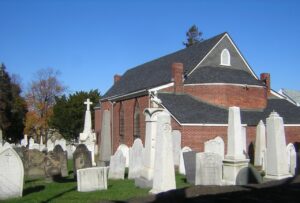Known as the oldest Catholic cemetery in Boston, Saint Augustine Cemetery in South Boston will celebrate its two hundred and third anniversary in 2021. Built in 1818 by the first Catholic Bishop of Massachusetts, Fr. John Louis Ann Magdalen Lefebvre de Cheverus (1768-1836), the cemetery’s first burial was that of Fr. Francis Anthony Matignon, one of the first Catholic priests in Massachusetts. Less than a year later, on 4 July 1819, the Saint Augustine Chapel was inaugurated as a mortuary chapel to honor Fr. Matignon. The Saint Augustine Chapel is, to this day, the oldest surviving Catholic church and Gothic Revival church in Massachusetts.[1]
To mark its historic significance, the Saint Augustine Cemetery Records, 1819-1859 database was established a couple of years ago thanks to a partnership between the New England Historic Genealogical Society and the Archdiocese of Boston; it is an important resource if you are interested in learning more about the history of Catholicism in New England, immigration in the nineteenth century, and the history of Boston. The database is comprised of a mix of original records and copied volumes that include lot sales, burials, deaths, and gravestone inscriptions. It also contains a set of volumes named “Gravestone Inventory,” which were created in the 1980s after a preservation study of the cemetery.
The database is comprised of a mix of original records and copied volumes that include lot sales, burials, deaths, and gravestone inscriptions.
In addition to the database, NEHGS holds a manuscript titled “Stone Inscriptions in St. Augustine’s Cemetery, South Boston, 1819-1900” by George F. O’Dwyer (in the R. Stanton Avery Special Collections) which may be of interest for anyone looking to do further research on the subject. Outside NEHGS, you can also find the Thomas Murray Family papers, which are available at the John J. Burns Library at Boston College. This collection of papers created by a St. Augustine Chapel’s sexton includes a record of burials that date from 1833 until his own death in 1839.
Even though small, the Saint Augustine Chapel and Cemetery is an important part of the history of nineteenth-century Boston. From this small cemetery and church, we can learn about the struggles the Irish immigrants had to face coming to a new land across the ocean. Because it was the first Catholic cemetery and one of the oldest Catholic churches we have record of in New England, Saint Augustine also became a reference point for the settlement of the growing Irish community in South Boston, which is noticeable to this day. Since 1987, the cemetery and chapel have been included in the National Register of Historic Places as a national landmark.
Note
[1] Minxie J. Fannin and Leslie Larson, History of Saint Augustine’s Chapel and Cemetery (1980), https://archive.org/details/historyofsaintau00fann/page/n1/mode/2up.
Share this:

About Diana Beltrão
Originally born in Brazil, Diana holds a BA in History from the University of Brasilia, a MA in Religion from Yale University, and a MLS from Simmons University. She started at NEHGS as an intern in the Spring 2020 and was later hired as a Digitization Assistant in the Summer. Her previous experiences include adult education, the Yale Divinity Library, and an internship at Historic New England.View all posts by Diana Beltrão →
